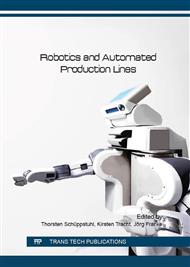p.66
p.74
p.82
p.91
p.99
p.107
p.114
p.123
p.132
System for the Estimation of Robot Cycle Times in Early Production Planning Phase
Abstract:
Obtaining the cycle time of robots mostly comes along with a simulation of the system. Setting up those simulations is time intensive and the costs for corresponding tools are often too high for small and medium sized enterprises. For manual assembly there are systems like MTM (methods-time-measurement) to calculate the cycle time in an easier way without using expensive software. For robotic applications like handling, assembly, welding, machining, and painting, such methods do not exist. This paper describes a method of a robot cycle time estimation. Starting with an analysis of the processes regarding their finite process elements, the robot tasks are divided into general elements and process related elements. In a second step, all elements are analysed regarding their characteristics and described in a mathematical way. Finally, the elements are combined to a calculation system.
Info:
Periodical:
Pages:
99-106
Citation:
Online since:
June 2016
Authors:
Keywords:
Price:
Сopyright:
© 2016 Trans Tech Publications Ltd. All Rights Reserved
Share:
Citation:


